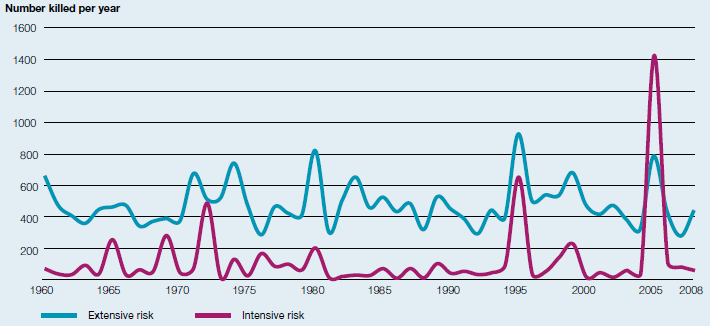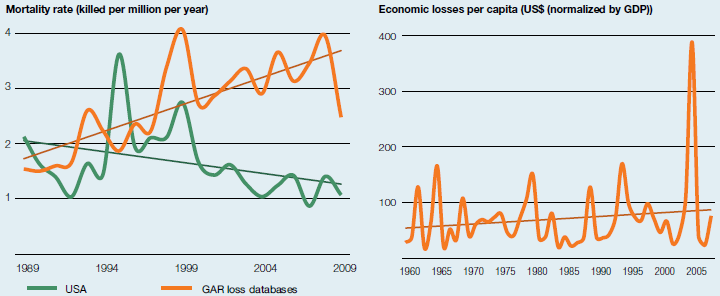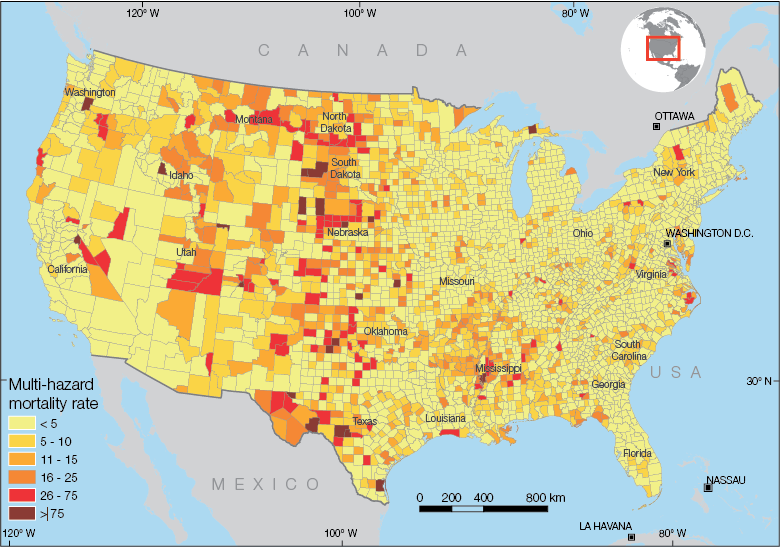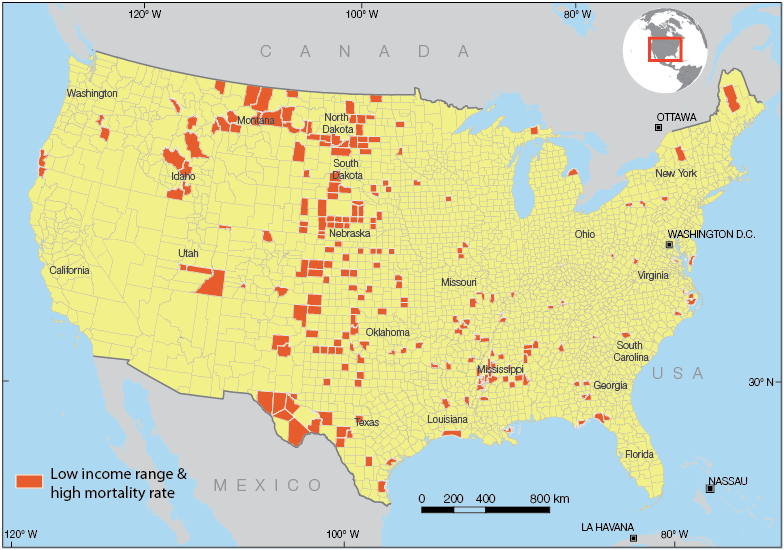 |
Global Assessment Report on Disaster Risk Reduction 2011
Revealing Risk, Redefining Development |


  |
|
Box 2.6 Extensive risk in the United States of America
Anyone looking for a safe place to live in the United States of America should consider moving to
Prince of Wales – Outer Ketchikan County in Alaska, the only county that does not report disaster
losses in the SHELDUS database.18 SHELDUS contains more than 640,000 local level disaster loss
reports in the United States of America for the period 1960–2009 (Borden and Cutter, 2008 Borden, K.A. and Cutter, S.L. 2008. Spatial patterns of natural hazards mortality in the United States. International Journal of Health Geographics 7 (64). ) and
provides a unique look at extensive risk in a high-income country.. Unlike low- and middle-income-countries, mortality due to disasters in the United States of America is extensively distributed. Most (89 percent) of the mortality since 1960 corresponds to extensive disasters (Figure 2.28). SHELDUS records 26,936 deaths between 1960 and 2008 compared with 18,273 in the Emergency Events Database (EM-DAT). In contrast, two-thirds of the economic loss is intensively concentrated in only 0.4 percent of the reports. Figure 2.28
Extensive and intensive mortality in the USA  Figure 2.29 shows that, compared with the other countries in the data universe, mortality in extensive disasters in the United States of America is falling. Figure 2.30, however, shows that even when normalized by GDP per capita, economic loss is rising. Figure 2.29 (left)
Mortality per capita per year in extensive disasters: United States of America compared with Africa, Asia, Latin America and the Middle East Figure 2.23 (right) Economic loss per capita, normalized by GDP  The highest extensive risk mortality rates are strongly associated with a wide geographical corridor that stretches from the north to the southwest of the United States of America, through the states of North and South Dakota, Nebraska, Kansas, Oklahoma and Arkansas (Figure 2.31). Figure 2.31
Multi-hazard crude mortality rate (accumulated mortality per million per year) per county, United States of America, 1960–2009  
(Sources: mortality rates from SHELDUS (without Hurricane Katrina); population (year 2006) from the US Census Bureau)
As Figure 2.32 shows, 220 out of the 302 counties (73 percent) with annual mortality rates greater than 15 per million had average annual household incomes of less than US$40,000. Many are sparsely populated counties in the north-to-southwest corridor mentioned above. Figure 2.32
Counties with low average annual income and high mortality rates, United States of America, 1960–2009 
(Sources: income and population (2006) from the US Census Bureau; loss data from SHELDUS. Mortality due to Hurricane Katrina not included)
(Source:  Serje, 2010a Serje, 2010a Serje, J. 2010. Extensive and intensive risk in the USA: A comparative with developing economies. Case study prepared for the 2011 Global Assessment Report on Disaster
Risk Reduction. Geneva, Switzerland: UNISDR. Serje, J. 2010. Extensive and intensive risk in the USA: A comparative with developing economies. Case study prepared for the 2011 Global Assessment Report on Disaster
Risk Reduction. Geneva, Switzerland: UNISDR.Click here to view this GAR paper. Note 18 SHELDUS uses different attributes to the other disaster
loss databases analysed in GAR11, and contains data
on mortality and economic losses at the county level in
all 50 states in the United States of America, but does
not record other attributes such as housing damage and
destruction. Data for this case study were drawn from
the Spatial Hazard Events and Losses Database for the
United States, Version 8.0. Hazards and Vulnerability
Research Institute (2010). Columbia, University of
South Carolina, www.sheldus.org. |
  |
